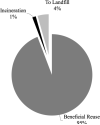Partitioning, persistence, and accumulation in digested sludge of the topical antiseptic triclocarban during wastewater treatment
- PMID: 16786704
- PMCID: PMC2768036
- DOI: 10.1021/es052245n
Partitioning, persistence, and accumulation in digested sludge of the topical antiseptic triclocarban during wastewater treatment
Abstract
The topical antiseptic agent triclocarban (TCC) is a common additive in many antimicrobial household consumables, including soaps and other personal care products. Long-term usage of the mass-produced compound and a lack of understanding of its fate during sewage treatment motivated the present mass balance analysis conducted at a typical U.S. activated sludge wastewater treatment plant featuring a design capacity of 680 million liters per day. Using automated samplers and grab sampling, the mass of TCC contained in influent, effluent, and digested sludge was monitored by isotope dilution liquid chromatography (tandem) mass spectrometry. The average mass of TCC (mean +/- standard deviation) entering and exiting the plant in influent (6.1 +/- 2.0 microg/L) and effluent (0.17 +/- 0.03 microg/ L) was 3737 +/- 694 and 127 +/- 6 g/d, respectively, indicating an aqueous-phase removal efficiency of 97 +/- 1%. Tertiary treatment by chlorination and sand filtration provided no detectable benefit to the overall removal. Due to strong sorption of TCC to wastewater particulate matter (78 +/- 11% sorbed), the majority of the TCC mass was sequestered into sludge in the primary and secondary clarifiers of the plant. Anaerobic digestion for 19 days did not promote TCC transformation, resulting in an accumulation of the antiseptic compound in dewatered, digested municipal sludge to levels of 51 +/- 15 mg/kg dry weight (2815 +/- 917 g/d). In addition to the biocide mass passing through the plant contained in the effluent (3 +/- 1%), 76 +/- 30% of the TCC input entering the plant underwent no net transformation and instead partitioned into and accumulated in municipal sludge. Based on the rate of beneficial reuse of sludge produced by this facility (95%), which exceeds the national average (63%), study results suggest that approximately three-quarters of the mass of TCC disposed of by consumers in the sewershed of the plant ultimately is released into the environment by application of municipal sludge (biosolids) on land used in part for agriculture.
Figures





Comment in
-
Triclocarban seems to defy wastewater treatment.Environ Sci Technol. 2006 Jun 1;40(11):3444-5. doi: 10.1021/es0626988. Environ Sci Technol. 2006. PMID: 16786673 No abstract available.
References
-
- McAvoy DC, Schatowitz B, Jacob M, Hauk A, Eckhoff WS. Measurement of triclosan in wastewater treatment systems. Environ. Toxicol. Chem. 2002;21:1323–1329. - PubMed
-
- Gledhill WE. Biodegradation of 3,4,4'-trichlorocarbanilide, TCC, in sewage and activated sludge. Water Res. 1975;9:649–654.
-
- Kolpin DW, Furlong ET, Meyer MT, Thurman EM, Zaugg SD, Barber LB, Buxton HT. Pharmaceuticals, Hormones, and Other Organic Wastewater Contaminants in U.S. Streams, 1999-2000: A National Reconnaissance. Environ. Sci. Technol. 2002;36:1202–1211. - PubMed
-
- Halden RU, Paull DH. Co-occurrence of Triclocarban and Triclosan in U.S. Water Resources. Environ. Sci. Technol. 2005;39:1420–1426. - PubMed
-
- Heidler J, Halden RU. Fate of Antimicrobial Compounds During Wastewater Treatment. Abstr. Pap. Am. Chem. Soc. 2004;228:U620–U620.
Publication types
MeSH terms
Substances
Grants and funding
LinkOut - more resources
Full Text Sources
Other Literature Sources

